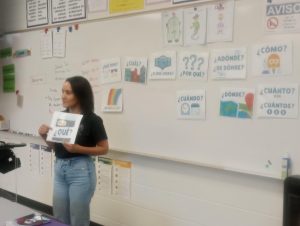As people face globalism and with opportunities to connect to more people through social media, the desire to be capable of communicating with a myriad of people from different cultures and different languages is on the rise.
With this, people find it desirable to be multilingual.
In a recent survey conducted at Rancho Cucamonga High School, 142 students responded. Of those students, 43.6% of students said they want to learn one additional language and 37.1% of students want to learn two additional languages.
The process of learning a language is both fascinating and challenging. From the earliest periods in one’s childhood, one can pick up on the language spoken by parents, guardians, or caretakers.
“Spanish is my first language,” Ms. Rosa Gallegos, Spanish teacher at RCHS said. “I learned it as all first languages are learned, at home with my family.”
It is an insightful observation that children can learn multiple languages only if the people they interact with speak it; but once people become older, even with hours of work, it is noticeably harder to become completely fluent in the language.

“If you are forced to learn the old school way, it can be boring and easy to forget,” Ms. Madison Cabral, Spanish and social emotional learning teacher at RCHS said. “Also, you can get stuck in a negative thought loop like ‘I’m just not good at Spanish’ and then you don’t try anymore.”
According to Verbal Planet, there are multiple domains one must endure and overcome to become fluent in the language of one’s choice. These domains require hard work and diligent effort to overcome but show the main areas one must conquer to become fluent.
“English is my first language,” Cabral said. “I learned Spanish the traditional way of memorizing vocabulary lists and copying grammar charts starting in eighth grade.”
Brandon Lee is a senior who participated in the biliteracy test for Spanish with the knowledge he gained from participating in Spanish classes at RCHS.

“It was difficult [to learn] the grammatical structure of the language while simultaneously learning new words and phrases because although some aspects of the language are similar to English, a lot of it also differs,” Lee said. “I found it hard to focus on learning a new language due to the size and structure of the Spanish language, however, I eventually overcame this issue as the years went on through my teachers and their different perspectives.”
By implementing strategies to embrace the challenges of the language learning journey, a student can gradually become more and more fluent in it.
According to the same survey, 61.5% of students said they have attempted to learn a language but gave up.
“Two of the biggest obstacles in language learning in my opinion are hesitancy, or being afraid or timid about the way one might sound,” Gallegos said. “Language acquisition requires the guts to take risks, without fear of the way one may sound. The other obstacle is having a default language to fall back on. If one doesn’t have to use the new language, there is no opportunity to practice.”
While gaining exposure through “watching TV shows or listening to music” is a good way to become more familiar with the language according to Gallegos, you can also try activities that might suit your personality more. For example, traveling to a country that speaks that language can help you in your language-learning journey.
“I was first exposed [to Spanish] when I did a study abroad year in Santander, Spain between high school and college through AFS Intercultural Programs,” Ms. Heidi Evans, Spanish teacher and former German teacher said.
With her participation in the study abroad program, Evans said she was even inspired to pursue her current career.









